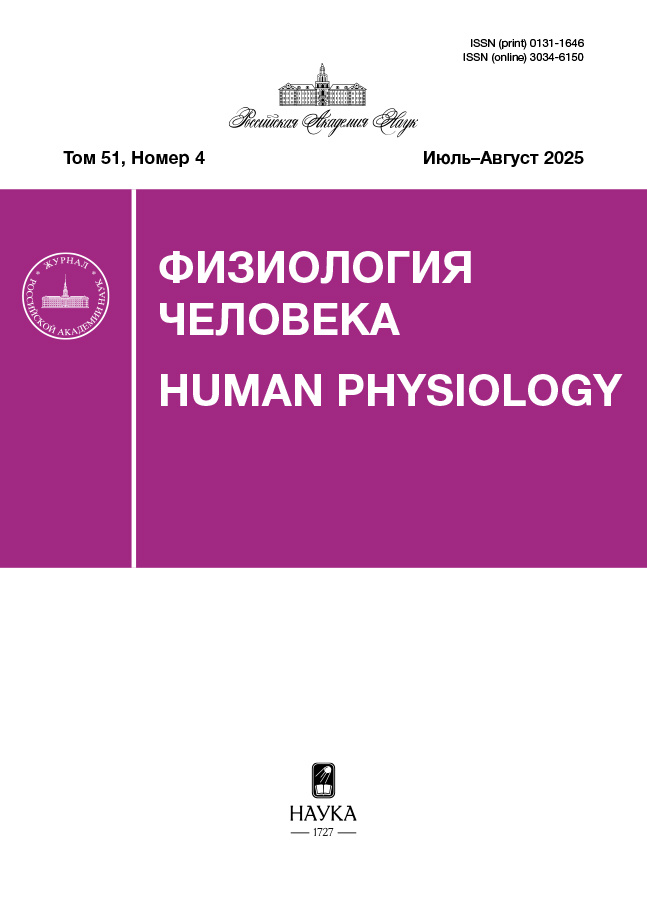Evoked Potentials of the Human Midbrain and Cortex Registered in Response to the Transition from a Consonant to a Vowel Sound
- Authors: Kantserova A.O.1, Oknina L.B.1, Pitskhelauri D.I.2, Podlepich V.V.2, Vologdina Y.O.1,2, Sieber I.A.3, Strelnikova E.V.4
-
Affiliations:
- Institute of Higher Nervous Activity and Neurophysiology, RAS
- N.N. Burdenko National Medical Research Center of Neurosurgery
- National Research University Higher School of Economics
- Institute of Higher Nervous Activity and Neurophysiology
- Issue: Vol 50, No 6 (2024)
- Pages: 3-12
- Section: Articles
- URL: https://cardiosomatics.ru/0131-1646/article/view/664068
- DOI: https://doi.org/10.31857/S0131164624060013
- EDN: https://elibrary.ru/AGSBFC
- ID: 664068
Cite item
Abstract
Speech is a continuous stream of sounds. To perceive speech, it is necessary to allocate discrete units with different frequency, volume and duration during its sounding. The purpose of this study was to identify the responses of the human cortex and midbrain to the transition from a consonant to a vowel sound in a syllable. The study analyzed and compared evoked potentials (EP) recorded using deep electrodes in 2 patients during intraoperative monitoring (IOM) with EP recorded in 29 healthy volunteers from the head surface. Groups of peaks following the beginning of the stimulus sound and the transition from consonant to vowel sound were detected on the EP registered in response to syllables and vowel sounds. Similar groups of short-latency peaks – S (from “start”) and C (from “change”), following the beginning of the stimulus sound and the transition from consonant to vowel sound, respectively, were distinguished on the patients’ EP. Their latencies had no significant differences (p > 0.05). Similarly, complexes of long-latent peaks N1S-P2S and N1C-P2C, similar to each other, were isolated on the EP of healthy volunteers. Their latencies also had no significant differences (p > 0.05). During the sounding of the stimulus, the cortex performs high-level (cognitive) sound processing, while the midbrain performs low-level (primary) processing, firstly providing rapid transmission of information to the cortex. With pathologies of the auditory structures of the thalamus and cortex, the ability to respond to changes in the characteristics of sound during its sounding, including speech, is likely to be impaired or lost.
Keywords
Full Text
About the authors
A. O. Kantserova
Institute of Higher Nervous Activity and Neurophysiology, RAS
Author for correspondence.
Email: anna.kantserova@gmail.com
Russian Federation, Moscow
L. B. Oknina
Institute of Higher Nervous Activity and Neurophysiology, RAS
Email: anna.kantserova@gmail.com
Russian Federation, Moscow
D. I. Pitskhelauri
N.N. Burdenko National Medical Research Center of Neurosurgery
Email: anna.kantserova@gmail.com
Russian Federation, Moscow
V. V. Podlepich
N.N. Burdenko National Medical Research Center of Neurosurgery
Email: anna.kantserova@gmail.com
Russian Federation, Moscow
Y. O. Vologdina
Institute of Higher Nervous Activity and Neurophysiology, RAS; N.N. Burdenko National Medical Research Center of Neurosurgery
Email: anna.kantserova@gmail.com
Russian Federation, Moscow; Moscow
I. A. Sieber
National Research University Higher School of Economics
Email: anna.kantserova@gmail.com
Russian Federation, Moscow
E. V. Strelnikova
Institute of Higher Nervous Activity and Neurophysiology
Email: anna.kantserova@gmail.com
Russian Federation, Moscow
References
- Boruta L., Peperkamp S., Crabbé B., Dupoux E. Testing the robustness of online word segmentation: Effects of linguistic diversity and phonetic variation / Proceedings of the 2nd workshop on cognitive modeling and computational linguistics. Portland. Oregon. USA, 2011. P. 1.
- Kuhl P.K. Early language acquisition: Cracking the speech code // Nat. Rev. Neurosci. 2004. V. 5. № 11. P. 831.
- Shea C., Curtin S. Discovering the relationship between context and allophones in a second language: evidence for distribution-based learning // Stud. Second Lang. Acquis. 2010. V. 32. № 4. P. 581.
- Ashby M., Maidment J. Introducing phonetic science. Cambridge: Cambridge University Press, 2005. 230 p.
- Kodzasov S.V., Krivnova O.F. [General phonetics]. Moscow: RGGU, 2001. 592 p.
- Oxenham A.J. How we hear: The perception and neural coding of sound // Annu. Rev. Psychol. 2018. V. 69. № 1. P. 27.
- Lau B.K., Mehta A.H., Oxenham A.J. Superoptimal perceptual integration suggests a place-based representation of pitch at high frequencies // J. Neurosci. 2017. V. 37. № 37. P. 9013.
- Kandel E.R., Koester J.D., Mack S.H., Siegelbaum S.A. Principles of neural science. 6th ed. New York: McGraw-Hill Professional, 2021. 1696 p.
- Dorfman L.J. Sensory evoked potentials: clinical applications in medicine // Annu. Rev. Med. 1983. V. 34. P. 473.
- Picton T.W., Hillyard S.A., Krausz H.I., Galambos R. Human auditory evoked potentials. I: Evaluation of components // Electroencephalogr. Clin. Neurophysiol. 1974. V. 36. № 2. P. 179.
- Kantserova A.O., Oknina L.B., Pitskhelauri D.I. et al. Evoked Potentials of the Midbrain Associated with the Beginning and End of a Sound of a Simple Tone // Human Physiology. 2022. V. 48. № 3. Р. 229.
- Nakagawa K., Otsuru N., Inui K., Kakigi R. Change-related auditory P50: A MEG study // NeuroImage. 2014. V. 86. P. 131.
- Hillyard S.A., Picton T.W. ON and OFF components in the auditory evoked potential // Percept. Psychophys. 1978. V. 24. № 5. P. 391.
- Kim J.R. Acoustic change complex: Clinical implications // J. Audiol. Otol. 2015. V. 19. № 3. P. 120.
- Ostroff J.M., Martin B.A., Boothroyd A. Cortical evoked response to acoustic change within a syllable // Ear. Hear. 1998. V. 19. № 4. P. 290.
- Kaukoranta E., Hari R., Lounasmaa O.V. Responses of the human auditory cortex to vowel onset after fricative consonants // Exp. Brain Res. 1987. V. 69. № 1. P. 19.
- Eggermont J. Auditory brainstem response // Handb. Clin. Neurol. 2019. V. 160. P. 451.
- Krizman J., Kraus N. Analyzing the FFR: A tutorial for decoding the richness of auditory function // Hear. Res. 2019. V. 382. P. 107779.
- Johnson K.L., Nicol T., Zecker S.G. et al. Brainstem encoding of voiced consonant--vowel stop syllables // Clin. Neurophysiol. 2008. V. 119. № 11. P. 2623.
- Nourski K.V., Steinschneider M., Rhone A.E. et al. Sound identification in human auditory cortex: Differential contribution of local field potentials and high gamma power as revealed by direct intracranial recordings // Brain Lang. 2015. V. 148. P. 37.
- Moses D.A., Mesgarani N., Leonard M.K., Chang E.F. Neural speech recognition: Continuous phoneme decoding using spatiotemporal representations of human cortical activity // J. Neural. Eng. 2016. V. 13. № 5. P. 056004.
- Parsons C.E., Young K.S., Joensson M. et al. Ready for action: A role for the human midbrain in responding to infant vocalizations // Soc. Cogn. Affect. Neurosci. 2014. V. 9. № 7. P. 977.
- Sala F., Lanteri P., Bricolo A. Motor evoked potential monitoring for spinal cord and brain stem surgery // Adv. Tech. Stand. Neurosurg. 2004. V. 29. P. 133.
- Kantserova А.O., Oknina L.B., Pitskhelauri D.I. et al. Evoked potentials appearing in the human midbrain after sounding of a simple tone // Neurosci. Behav. Physiol. 2023. V. 53. № 3. Р. 358.
- Van Hooff J.C., De Beer N.A.M., Brunia C.H.M. et al. Event-related potential measures of information processing during general anesthesia // Electroencephalogr. Clin. Neurophysiol. 1997. V. 103. № 2. P. 268.
Supplementary files













